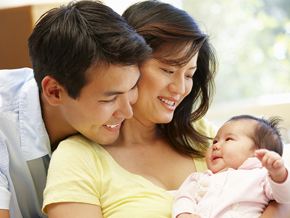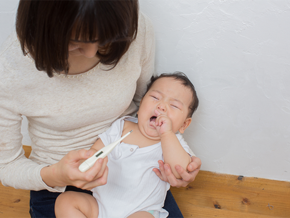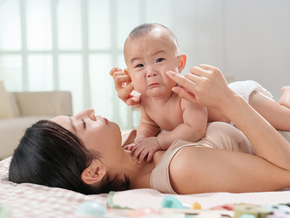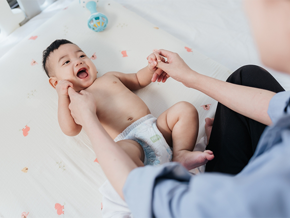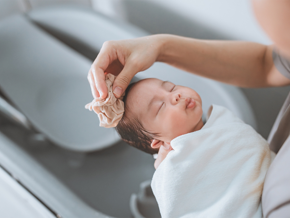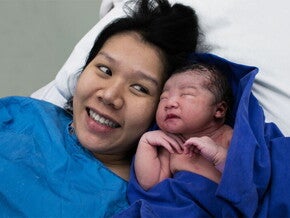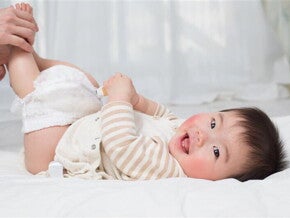
Once your little one starts wiggling their fingers and kicks a ball for the first time, they're showing off those motor skills. These movements may look simple, but they also help them explore, play, and learn.
Here's a guide to help you understand your child's motor developmental stages, including infant and toddler milestones, and why they are so crucial during the early years.
What Are Motor Skills?
Motor skills are how your child moves and uses their body. In the early childhood stage, they help your child express what they want when they are unable to or are still learning how to talk.
There are two types of motor skills:
- Gross motor skills: These are the bigger movements that involve large muscles, like sitting, standing, walking, or jumping.
- Fine motor skills: These are the smaller, more detailed movements, such as picking up food with fingers, turning book pages, or scribbling with a crayon.
At each age, there are specific movements and abilities you can expect to see. These motor milestones give you (and your pediatrician) a general idea of how your child's physical development is progressing.
Motor Developmental Milestones (First Five Years)
Below, you'll find the age-specific motor skills, based on developmental checklists from the American Academy of Pediatrics (AAP) and the Centers for Disease Control and Prevention (CDC).
Motor skills at 2 months
These initial movements help set the stage for crucial gross motor skills later on, such as rolling over and sitting up.
• Your baby can hold their head up when on their tummy.
• They can move both arms and legs.
• They can open their hands briefly (an early step in fine motor development).
Supervised tummy time can help your child develop their ability to hold their head up and strengthen their neck. When they're this young, though, make sure to keep each tummy time session under five minutes.
Motor skills at 4 months

One important gross motor milestone at this age: "push-up" attempts when they're on their stomach!
You'll start to see more control and purpose in your baby's movements.
- Your baby holds their head steady without support when you're holding your baby
- They can hold a toy when you place it in their hand.
- Your baby now uses their arms to swing at toys
- They often bring their hands to their mouths.
- They push up onto their elbows or forearms during tummy time.
Letting your baby grab onto something in their hand is one of the simplest things you can do to help build their fine motor skills!
Motor skills at 6 months
By now, your baby is getting stronger and more active.
- Your baby can now roll from tummy to back.
- They push up with straight arms when on their tummy.
- They lean on their hands to support themselves when sitting.
This guide on your 6-month-old baby's milestones outlines what else to expect in your child's development.
Motor skills at 9 months
Your baby is becoming more coordinated in both gross and fine motor skills.
- Your baby can now get to a sitting position on their own.
- They can sit without your support.
- Your baby will use their fingers to "rake" food toward them.
- They can move objects from one hand to the other.
One excellent opportunity for fine motor activities is mealtimes, as your baby will want to use their hands frequently.
Motor skills at 12 months
Get ready because your child is approaching their toddler years!
- Your baby will now be able to pull up to stand.
- They will walk while holding onto furniture (also called "cruising").
- Your baby will drink from a cup without a lid as you hold it.
- They will pick up small food pieces using their thumb and pointer finger.
Explore this complete list of milestones your 1-year-old baby achieves!
Motor skills at 15 to 18 months
Your baby, now officially a toddler, is on the move, and they're curious about everything.
- Your baby can now take a few steps alone.
- They use their fingers to feed themselves.
- Your toddler can walk without help by 18 months.
- They will scribble.
- They will try to use a spoon to feed themselves.
- They will drink from a lidless cup (expect spills!)
- Your toddler can now climb on and off furniture without help.
Offering motor skill activities for toddlers, such as stacking blocks or walking on soft mats, can support their natural development.
Motor skills at 24 months (2 years)
Running after your child is your exercise at this stage.
- Your child can run now.
- They can kick a ball.
- They can walk up a few stairs with or without help.
- They can now eat with a spoon (can still be messy).
While your child is making more controlled, purposeful movements, they may still fall and tumble, and that's okay. Falling and then letting them get up on their own helps build their confidence.
Motor skills at 30 months (2.5 years)
Your child's fine motor coordination is improving along with their body awareness.
- Your toddler can now use their hands to twist doorknobs or jar lids.
- They can take some clothes off, like pants or jackets.
- They can jump with both feet.
- They can turn book pages one at a time.
These abilities are helpful as your toddler becomes more involved in gross motor activities.
Motor skills at 3 years
Your child is increasingly becoming independent. They probably want to climb those stairs to go up the slide alone now.
• Your child can string large items together, like beads or macaroni.
• They can put on some clothes without your help (they will likely insist on their fashion preferences, too).
• They now know how to use a fork.
All these tasks require a mix of balance, hand-eye coordination, and finger strength. Playtime does a lot in helping to improve motor skills.
Motor skills at 4 years
Your child is definitely showing signs of school readiness!
• Your child can catch a large ball most of the time.
• They can serve you food or pour water with help.
• They can now unfasten some buttons.
• Your child now holds a pencil or crayon between fingers and thumb.
Not holding a pencil or crayon in a fist indicates that your child is developing better finger control and coordination.
Motor skills at 5 years
At this stage, your child is nearing the point where they can master many daily tasks independently.
- Your child knows their way around most buttons.
- They can hop on one foot.
Milestones that showcase your child's growing independence mean they're ready for kindergarten!
Helping Your Child's Motor Development
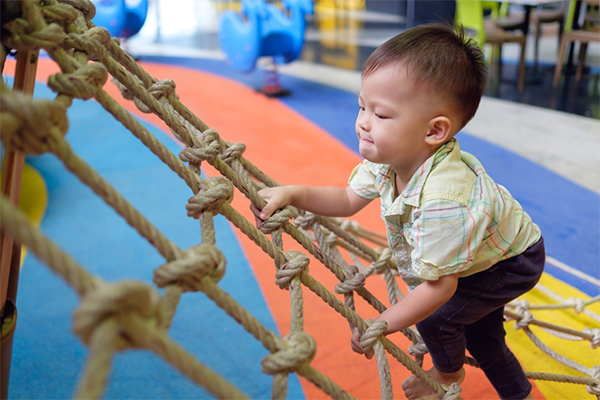
Active play like running, climbing or jumping, allows your child to practice and improve their motor skills.
The best way for you to support your child's motor development is through play, daily routines, and providing a suitable space. Here are a few things that can help:
1. Make play purposeful.
Play is one of the most effective ways to support your child's development. Studies show that goal-oriented play, or structured play where kids have to reach a target or finish a task, can significantly improve both gross and fine motor skills.
Activities like stacking blocks, tossing toys into a bin, or completing simple obstacle courses encourage your child to use different muscle groups.
2. Give your child room to move.
Tummy time for babies, play mats for crawlers, and safe open spaces for toddlers all encourage movement that builds strength and coordination.
3. Offer toys and tools that match their stage.
Soft rattles, stacking cups, large crayons, and toy balls help with grip, balance, and coordination. As your child grows, toys that encourage activities such as pushing, pulling, catching, or building can support both fine and gross motor development.
4. Let your toddler try things for themselves.
Even if it gets messy, let your child try using a spoon, tying their shoelaces, or pouring water from a pitcher. These tasks build fine motor control and confidence.
5. Keep routines unhurried when possible.
Kids need more time to practice new movements. Rushing through meals, baths, or dressing can make it harder for them to use their growing skills.
Why Motor Skills Matter in Child Development
As research from the Nestlé Nutrition Workshop Series highlights, motor development is deeply connected to how your child thinks, talks, and relates to others.
- When your baby learns to sit up, they can suddenly see more of the world and play with both hands.
- When they start crawling or walking, they can explore different spaces on their own.
- When they develop better hand control, they can feed themselves, stack blocks, or draw, which helps promote independence and creativity.
These physical changes also support aspects such as language development, emotional growth, and problem-solving.
Keep in mind that daily routines, the way children are cared for, and many other factors can influence when specific skills emerge. That's why these age-based milestones are helpful as general guides, not hard rules.
The important thing is that your child is showing progress in their motor skills over time. If you ever have concerns, don't hesitate to check in with your pediatrician.
Show your child's latest motor skills at the ParentTeam Moms and Dads Facebook Group!
References
“2 Month - 5 Early Relational Health Developmental Milestone Timeline,” n.d. https://www.aap.org/en/patient-care/early-childhood/milestone-timeline/
Brown University Health. “Children’s Developmental Milestones: Gross and Fine Motor Skills | Brown University Health.” Accessed August 28, 2025. https://www.brownhealth.org/be-well/childrens-developmental-milestones-gross-and-fine-motor-skills
NAEYC. “Help Your Child Build Fine Motor Skills,” n.d. https://www.naeyc.org/our-work/families/help-your-child-build-fine-motor-skills
National Institute of Education (NIE). “The Importance of Motor Skills in Child Development and Strategies to Boost Them,” February 6, 2025. https://www.ntu.edu.sg/nie/news-events/news/detail/the-importance-of-motor-skills-in-child-development-and-strategies-to-boost-them











